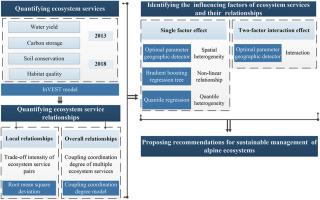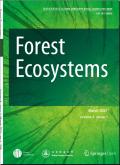Multidimensional factors influencing ecosystem services and their relationships in alpine ecosystems: A case study of the Daxing'anling forest area, Inner Mongolia
IF 4.4
1区 农林科学
Q1 FORESTRY
引用次数: 0
Abstract
Understanding the influencing factors of ecosystem services (ESs) and their relationships is essential for sustainable ecosystem management in degraded alpine ecosystems. There is a lack of integrated multi-model approaches to explore the multidimensional influences on ESs and their relationships in alpine ecosystems. Taking the Daxing'anling forest area, Inner Mongolia (DFAIM) as a case study, this study used the integrated valuation of ecosystem services and trade-offs (InVEST) model to quantify four ESs—soil conservation (SC), water yield (WY), carbon storage (CS), and habitat quality (HQ)—from 2013 to 2018. We adopted root mean square deviation (RMSD) and coupling coordination degree models (CCDM) to analyze their relationships, and integrated three complementary approaches—optimal parameter-based geographical detector model (OPGDM), gradient boosting regression tree model (GBRTM), and quantile regression model (QRM)—to reveal multidimensional influencing factors. Key findings include the following: (1) From 2013 to 2018, WY, SC, and HQ declined while CS increased. WY was primarily influenced by mean annual precipitation (MAP), forest ratio (RF), and soil bulk density (SBD); CS and HQ by RF and population density (PD); and SC by slope (S), RF, and MAP. Mean annual temperature (MAT), gross domestic product (GDP), and road network density (RND) showed increasing negative impacts. (2) Low trade-off intensity (TI < 0.15) dominated all ES pairs, with RF, MAP, PD, and normalized difference vegetation index (NDVI) being the dominant factors. The factor interactions primarily showed two-factor enhancement patterns. (3) The average coupling coordination degree (CCD) of the four ESs was low and declined over time, with low-CCD areas becoming increasingly prevalent. RF, S, SBD, and NDVI positively influenced CCD, while PD, MAT, GDP, and RND had increasing negative impacts, with over 62% of the factor interactions exceeding the individual factor effects. In summary, ES supply generally decreased. Local relationships showed moderate coordination, while overall relationships indicated primary dysfunction. Land use and natural factors primarily shaped these ES and their relationships, while climate and socioeconomic changes diminished ES supply and intensified competition. We recommend enhancing the resilience of natural systems rather than replacing them, establishing climate adaptation monitoring systems, and promoting conservation tillage and cross-departmental coordination mechanisms for collaborative ES optimization. These results provide valuable insights into the sustainable management of alpine ecosystems.

高寒生态系统服务功能的多维影响因素及其关系——以内蒙古大兴安岭林区为例
了解生态系统服务功能的影响因素及其相互关系,对高寒退化生态系统的可持续管理具有重要意义。目前还缺乏综合的多模型方法来探讨高寒生态系统生态环境的多维影响及其相互关系。以内蒙古大兴安岭林区为例,采用生态系统服务与权衡综合评价(InVEST)模型,对2013 - 2018年内蒙古大兴安岭林区的土壤保持(SC)、水量(WY)、碳储量(CS)和生境质量(HQ)进行了量化分析。采用均方根偏差(RMSD)和耦合协调度模型(CCDM)分析二者之间的关系,并整合基于最优参数的地理探测器模型(OPGDM)、梯度增强回归树模型(GBRTM)和分位数回归模型(QRM)三种互补方法,揭示多维影响因素。主要发现如下:(1)2013 - 2018年,WY、SC和HQ下降,CS上升。WY主要受年平均降水量(MAP)、森林比(RF)和土壤容重(SBD)的影响;按RF和人口密度(PD)划分的CS和HQ;和SC的斜率(S), RF和MAP。年平均气温(MAT)、国内生产总值(GDP)和路网密度(RND)的负向影响逐渐增强。(2)低权衡强度(TI < 0.15)在所有ES对中占主导地位,RF、MAP、PD和归一化植被指数(NDVI)是优势因子。因子相互作用主要表现为双因子增强模式。(3) 4个生态系统的平均耦合配位度(CCD)较低,且随着时间的推移呈下降趋势,低耦合配位度区域越来越普遍。RF、S、SBD和NDVI正向影响CCD,而PD、MAT、GDP和RND的负向影响越来越大,超过62%的因子相互作用超过个体因子效应。综上所述,ES供应普遍减少。局部关系表现为中度协调,而整体关系表现为原发性功能障碍。土地利用和自然因素主要塑造了这些生态系统及其关系,而气候和社会经济变化减少了生态系统的供应,加剧了竞争。我们建议加强自然系统的恢复力,而不是取代它们,建立气候适应监测系统,促进保护性耕作和跨部门协调机制的协同ES优化。这些结果为高寒生态系统的可持续管理提供了有价值的见解。
本文章由计算机程序翻译,如有差异,请以英文原文为准。
求助全文
约1分钟内获得全文
求助全文
来源期刊

Forest Ecosystems
Environmental Science-Nature and Landscape Conservation
CiteScore
7.10
自引率
4.90%
发文量
1115
审稿时长
22 days
期刊介绍:
Forest Ecosystems is an open access, peer-reviewed journal publishing scientific communications from any discipline that can provide interesting contributions about the structure and dynamics of "natural" and "domesticated" forest ecosystems, and their services to people. The journal welcomes innovative science as well as application oriented work that will enhance understanding of woody plant communities. Very specific studies are welcome if they are part of a thematic series that provides some holistic perspective that is of general interest.
 求助内容:
求助内容: 应助结果提醒方式:
应助结果提醒方式:


